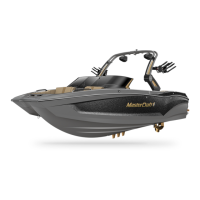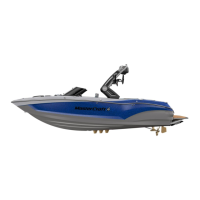2013 MasterCraft Owners Manual • Safety Knowledge • Page 1-9
PFD Accessibility
• Wearable PFDs must be readily ac-
cessible in the boat.
• It should be possible to put on the
PFDs within a reasonable amount of time
in case of emergency.
• PFDs should never be stowed in
plastic bags, in locked or closed compart-
ments or have other gear stowed on top
of them.
• The U.S. Coast Guard, as well as
MasterCraft, recommends the wearing
of PFDs at all times when the vessel is
underway, even though it is not a require-
ment. The best PFD is the one that is
worn–that is, the one that can save your
life.
• Inatable PFDs must have a full
cylinder and all status indicators on the
inator must be green, or the device is NOT serviceable, and is NOT considered a usable
PFD for anyone on-board the vessel.
• Coast Guard-approved inatable PFDs are authorized for use on recreational
boats by persons at least 16 years of age.
• Some states require children to wear PFDs at all times. Check with your state boat-
ing safety ocials for details. Be certain to equip children with a PFD that is appropriate
for the size of the child. The label will indicate the weight limits for use.
Sound Producing Devices
The navigation rules require sound signals to be made under certain circum-
stances. Meeting, crossing and overtaking situations, which will be described in some
detail shortly, are examples of when sound signals are required. Recreational vessels are
also required to sound signals during periods of reduced visibility. Your
MasterCraft boat is equipped with a horn, but you may also purchase
aftermarket devices in case of potential electrical disconnect or failure.
Note: The requirement to carry a bell on board no longer applies to
vessels operating on International Waters.
The following are standard signals when using a whistle:
One prolonged blast: warning.
One short blast: Pass on my port side.
Two short blasts: pass on my starboard side.
Three short blasts: my engines are in reverse.
Five or more blasts: danger!
Visual Distress Signals
All vessels used on coastal waters, the Great Lakes, territo-
rial seas and those waters connected directly to them up to a point
where a body of water is greater than two miles wide, must be
equipped with U.S.C.G.-approved visual distress signals. Vessels
owned in the United States but operating on the high seas must be
equipped with U.S.C.G.-approved visual distress signals.
Pyrotechnic visual distress signals must be Coast Guard-
approved, in serviceable condition and readily accessible. This means that:
• They are marked with an expiration date. Expired signals may be carried as extra
equipment, but cannot be counted toward meeting the visual distress signal require-
ment, since they may be unreliable.
• If pyrotechnic devices are selected, a minimum of three are required. That is, three
signals for day use and three signals for night. Some pyrotechnic signals meet both day
and night use requirements.
• Pyrotechnic devices should be stored in a cool, dry location, if possible. A water-

